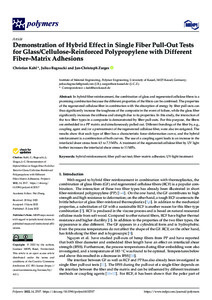Datum
2022-06-21Schlagwort
660 Chemische Verfahrenstechnik, Technische Chemie Ultraviolett-BestrahlungFaserverstärkungFaserverbundwerkstoffPolypropylenGlasfaserFaser-Matrix-HaftungCellulosefaserMetadata
Zur Langanzeige
Aufsatz

Demonstration of Hybrid Effect in Single Fiber Pull-Out Tests for Glass/Cellulose-Reinforced Polypropylene with Different Fiber–Matrix Adhesions
Zusammenfassung
In hybrid fiber reinforcement, the combination of glass and regenerated cellulose fibers is a promising combination because the different properties of the fibers can be combined. The properties of the regenerated cellulose fiber in combination with the absorption of energy by fiber pull-outs can thus significantly increase the toughness of the composite in the event of failure, while the glass fiber significantly increases the stiffness and strength due to its properties. In this study, the interaction of the two fiber types in a composite is demonstrated by fiber pull-outs.
For this purpose, the fibers are embedded in a PP matrix and simultaneously pulled out. Different bondings of the fiber by, e.g., coupling agent and/or a pretreatment of the regenerated cellulose fiber, were also investigated. The results show that each type of fiber has a characteristic force–deformation curve, and the hybrid reinforcement is a combination of both curves. The use of a coupling agent leads to an increase in the interfacial shear stress from 4.5 to 7.5 MPa. A treatment of the regenerated cellulose fiber by UV light further increases the interfacial shear stress to 11 MPa.
For this purpose, the fibers are embedded in a PP matrix and simultaneously pulled out. Different bondings of the fiber by, e.g., coupling agent and/or a pretreatment of the regenerated cellulose fiber, were also investigated. The results show that each type of fiber has a characteristic force–deformation curve, and the hybrid reinforcement is a combination of both curves. The use of a coupling agent leads to an increase in the interfacial shear stress from 4.5 to 7.5 MPa. A treatment of the regenerated cellulose fiber by UV light further increases the interfacial shear stress to 11 MPa.
Zitierform
In: Polymers Volume 14 / Issue 13 (2022-06-21) eissn:2073-4360Förderhinweis
Gefördert durch den Publikationsfonds der Universität KasselZitieren
@article{doi:10.17170/kobra-202208266760,
author={Kahl, Christian and Bagnucki, Julius and Zarges, Jan-Christoph},
title={Demonstration of Hybrid Effect in Single Fiber Pull-Out Tests for Glass/Cellulose-Reinforced Polypropylene with Different Fiber–Matrix Adhesions},
journal={Polymers},
year={2022}
}
0500 Oax
0501 Text $btxt$2rdacontent
0502 Computermedien $bc$2rdacarrier
1100 2022$n2022
1500 1/eng
2050 ##0##http://hdl.handle.net/123456789/14102
3000 Kahl, Christian
3010 Bagnucki, Julius
3010 Zarges, Jan-Christoph
4000 Demonstration of Hybrid Effect in Single Fiber Pull-Out Tests for Glass/Cellulose-Reinforced Polypropylene with Different Fiber–Matrix Adhesions / Kahl, Christian
4030
4060 Online-Ressource
4085 ##0##=u http://nbn-resolving.de/http://hdl.handle.net/123456789/14102=x R
4204 \$dAufsatz
4170
5550 {{Ultraviolett-Bestrahlung}}
5550 {{Faserverstärkung}}
5550 {{Faserverbundwerkstoff}}
5550 {{Polypropylen}}
5550 {{Glasfaser}}
5550 {{Faser-Matrix-Haftung}}
5550 {{Cellulosefaser}}
7136 ##0##http://hdl.handle.net/123456789/14102
<resource xsi:schemaLocation="http://datacite.org/schema/kernel-2.2 http://schema.datacite.org/meta/kernel-2.2/metadata.xsd"> 2022-08-26T07:16:19Z 2022-08-26T07:16:19Z 2022-06-21 doi:10.17170/kobra-202208266760 http://hdl.handle.net/123456789/14102 Gefördert durch den Publikationsfonds der Universität Kassel eng Namensnennung 4.0 International http://creativecommons.org/licenses/by/4.0/ hybrid reinforcement fiber pull-out test fiber-matrix adhesion UV-light treatment 660 Demonstration of Hybrid Effect in Single Fiber Pull-Out Tests for Glass/Cellulose-Reinforced Polypropylene with Different Fiber–Matrix Adhesions Aufsatz In hybrid fiber reinforcement, the combination of glass and regenerated cellulose fibers is a promising combination because the different properties of the fibers can be combined. The properties of the regenerated cellulose fiber in combination with the absorption of energy by fiber pull-outs can thus significantly increase the toughness of the composite in the event of failure, while the glass fiber significantly increases the stiffness and strength due to its properties. In this study, the interaction of the two fiber types in a composite is demonstrated by fiber pull-outs. For this purpose, the fibers are embedded in a PP matrix and simultaneously pulled out. Different bondings of the fiber by, e.g., coupling agent and/or a pretreatment of the regenerated cellulose fiber, were also investigated. The results show that each type of fiber has a characteristic force–deformation curve, and the hybrid reinforcement is a combination of both curves. The use of a coupling agent leads to an increase in the interfacial shear stress from 4.5 to 7.5 MPa. A treatment of the regenerated cellulose fiber by UV light further increases the interfacial shear stress to 11 MPa. open access Kahl, Christian Bagnucki, Julius Zarges, Jan-Christoph doi:10.3390/polym14132517 Ultraviolett-Bestrahlung Faserverstärkung Faserverbundwerkstoff Polypropylen Glasfaser Faser-Matrix-Haftung Cellulosefaser publishedVersion eissn:2073-4360 Issue 13 Polymers Volume 14 false 2517 </resource>
Die folgenden Lizenzbestimmungen sind mit dieser Ressource verbunden:


